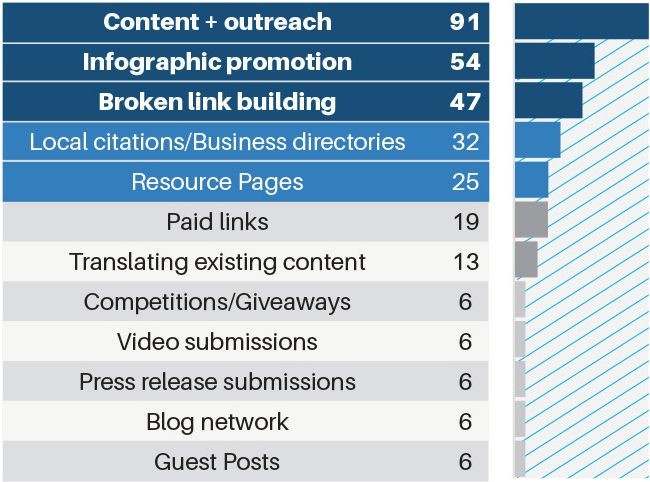Six Crucial Link Building Strategies to Drive Quality Traffic
Here are the six most important factors that will guide your link-building strategy and help you choose the perfect immediate tactics to implement on your website.
Here are the six most important factors that will guide your link-building strategy and help you choose the perfect immediate tactics to implement on your website.
Getting traffic to one’s site — and quality traffic at that — is probably one of the most overarching objectives of any SEO practitioner.
Since the days of Web 1.0, there have been many tactics that have enjoyed 15 seconds of fame and have then had to bow out due to the whip cracked by Google and its search algorithms.
One technique of driving traffic to one’s site, however, has remained evergreen and that is getting a high number of high quality links pointing to your site in the right context.
While the Panda and Penguin updates created many changes in the way we look at off-page and on-page SEO, Hummingbird makes it imperative that we get our link-building strategies completely Google-proof if we don’t want to be relegated to the dark dungeons of page two and beyond on a Google SERP.
But before you embark on your own link-building campaign, it is important to get your overall link-building strategy right. Here are the six most important factors that will guide your link-building strategy and help you choose the perfect immediate tactics to implement on your website.
While Google’s exact algorithms may be a little too fuzzy to dissect, they make the job of helping out SEO practitioners a tad easier by offering very distinct guidelines of what NOT to do.
Content that is scraped from renowned, well-ranked sites and is used purely as a magnet to attract search engines is a strict no-no. Make sure that if you do use content from other sites you modify it considerably to suit your site and its readers’ tastes. Include fresh data, opinions or views on the acquired content instead of just doing a ‘Copy-Paste’ job.
Low-quality guest posting is something to which Google has turned its attention (and hammer) since the start of the year. It strongly discourages the posting of thin, rehashed or inauthentic content that doesn’t provide substantial value to readers. An update to the Webmaster Guidelines last month put cookie-cutter guest posts in the same category as scraped content.
Syndicating your own content to well-read blogs and publishers like Yahoo is a great way of building links back to your site. However, if you have the exact same content on your site, too, you run a risk of being labelled as a content copycat and getting punished by search engines for no real fault of your own. Avoid this scenario by using rel=canonical attributes correctly in your HTML. Another way to prove that the content on your own website is original is to publish it before it is published elsewhere and use clear authorship markups that establish that it is your content and not copied content from a reputed publisher.
Doorway sites are another old black hat technique that Google frowns upon. Doorway sites are essentially a bunch of sites created with the sole purpose of driving traffic to one particular website and which offer no added value to the user. They use different keyword phrases or search strings to link back to the same site. When a user clicks on any of these sites, she is taken to the same linked site in spite of using different search keywords, thus spoiling her user experience on Google — something that Google does NOT take very kindly.
Running an affiliate program is a perfectly acceptable way to earn rank. However, if the affiliate sites that link to your website contain just copied product descriptions with a couple of comments from the affiliate site owner, they do absolutely nothing for improving the rankings of your site. If you do have to have affiliates linking into your webpages, make sure they are high quality sites that contain original content besides content about your product. An original review, accompanied by comments and product recommendations from a trusted blog owner would make a real difference in convincing a potential user as well as Googlebot.
P.S.: Here’s a PDF with some great Google-speak of what TO do to improve your SEO.
While the quality of the sites that link to yours is of paramount importance, it is equally important that these sites are relevant to your line of business. According to Google’s ranking principles, how useful a user finds a search result goes a long way in determining the rank your page will earn.
Approaching reputed sites to feature your content or offer you link backs will only be useful if these sites have anything to do with the keywords that are important to your business.
Use this simple four-step test to determine whether a link is relevant or not:
For instance, say you own an online fashion eyewear store. A link from a fire department blog may not be a direct fit. However, if the fire department’s blog has a post that talks about how your store donated free eyewear to all visually injured fire victims within their geographic jurisdiction, the link becomes far more relevant and useful in ranking your website.
Earning links is not just about picking one approach and sticking with it. While Google may tell us what not to do, there is no silver bullet that will offer you a ton of qualified and useful inbound links. By narrowing your link-building tactics to just one or two, you run the risk of it not being important enough or even being considered in Google’s ever-changing algorithms.
Link-building tactics that are still relevant in 2014 are many and include:
According to Rand Fishkin of Moz, there has been a clear shift in marketers’ link-building tactics in 2014 as compared to last year:
“…for example close to 50% said in 2013 that guest blogging was their staple tactic, in 2014 fewer than 15% listed it as one of their staple activities.”

Most Effective Link Building Tactics: Source
Most SEO practitioners are so focused on driving traffic and getting conversions from the traffic they receive that they forget a very important tenet of SEO: Brand building.
Yes, counter-intuitive though it may sound, building a strong brand ought to be one of the priorities of every SEO practitioner. The wider your brand awareness, the stronger your brand image. It will also take less effort to get high quality, voluntary backlinks than if your brand was a complete unknown.
However, the only way you can carve out a separate and unique identity for your brand is by blazing your own trails and not copying your competition. Think of brands like Nordstrom and Macy’s that both target the same type of customer. The approach they take to building their online reputations is poles apart. While Nordstrom dominates Pinterest and does a fair job of YouTube videos, Macy’s steals the show on Facebook. Macy’s focuses on events and product plugs to pull in the buzz about itself online, while Nordstrom uses street style palettes and celebrity fashion to reach out to its audience.

Macy’s (L) vs. Nordstrom (R) on Tumblr
The distinctly different paths taken by these natural competitors points to two important lessons:
That we need to have natural looking inbound links is a given by now. The days of cloaked URLs, link exchange schemes, keyword stuffing and other black hat techniques belong in the dark pages of SEO history that no one would want to revisit today.
However, if links are still important, the anchor text that these links use must be equally crucial, right?
Yes and no. It definitely is important to have anchor text that is relevant to your site or webpage, but using your keywords as anchor text for all your inbound links is a sure-fire way of coming under Google’s black hat practices radar and suffering the consequences.
Let me explain this with the example that we used earlier. If you write a guest post about “Challenges facing single brand retailers online” on a leading e-commerce blog like Smarter Commerce, a reference back to your website using anchor texts like, “great eyewear,” or, “cheap glasses,” would stick out like a sore thumb. Instead, if you were to link to a post on your corporate blog with anchor texts related to the referenced blog post, the result would be far more natural and would actually drive traffic to your blog and eventually your site.
The idea here is simple. Don’t be sales-y. Stop using your keywords as anchors for every link you build. Your reader is smarter than you think.
Let the links be natural and don’t worry about the anchor text not matching your keywords. As long as the link is relevant to the context of the article, your job is done.
Let Google be your shepherd. Need I say anything more?